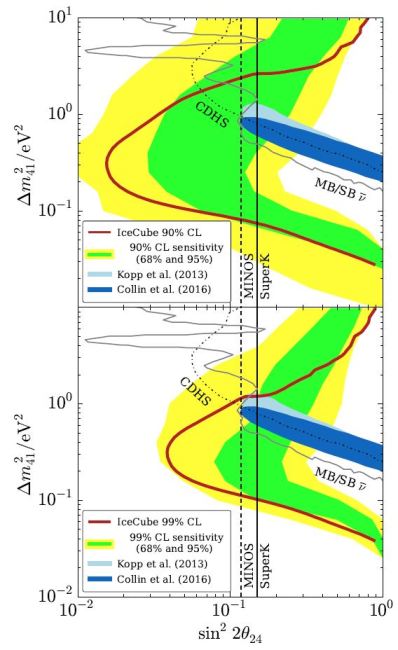Sterile Neutrinos with IceCUBE
 Andrii Terliuk (left) discussed the study of the sterile neutrino hypothesis with the IceCUBE detector. Unlike other experiments, for IceCUBE matter effects are important. Neutrinos interact with coherent forward scattering. Electron neutrinos have both CC and NC interactions in matter, while muon and tauon neutrinos only have neutral current interactions, and steriles would have none. This matter-induced difference in potential can enhance effects of sterile neutrinos, as it modifies the effective mixing parameters.
Andrii Terliuk (left) discussed the study of the sterile neutrino hypothesis with the IceCUBE detector. Unlike other experiments, for IceCUBE matter effects are important. Neutrinos interact with coherent forward scattering. Electron neutrinos have both CC and NC interactions in matter, while muon and tauon neutrinos only have neutral current interactions, and steriles would have none. This matter-induced difference in potential can enhance effects of sterile neutrinos, as it modifies the effective mixing parameters.
There can be a resonance effect due to the changes in amplitude and period of the oscillations. It is called neutrino oscillation length resonance, not a MSW resonance. It is a matter enhancement of sterile mixture in the earth’s mantle and core. For some specific values of the mixing angles, there can be enhancement in the disappearance of muon anti-neutrinos. The resonance energy is of the order of the TeV. The resonance enhancement for muon antineutrino is different depending on the mass splitting, direct proportional to the resonance energy.
IceCuBe has sensitivity to this effect, with its 5000 cherenkov light modules in 1 km^3 of ice. It can measure atmospheric neutrinos from hundreds of MeV to many TeV. The muon neutrino charged-current interactions have a different topology from the cascade-like NC interactions, or the CC electron and tau neutrino interactions.
 The up-going neutrino events are used to get rid of backgrounds. The range of energy studied is from 400 GeV to 20 TeV. The purity for neutrino events is 99.9%. The speaker showed a nice temperature map of energy versus arrival angle, where the effect of sterile neutrinos would be a strong enhancement in the disappearance probability for upward going neutrinos in the TeV range. The disappearance rate in that region is in the order of 10%. The result, published in Phys Rev. Lett. 117, 071801 (or in the arxiv here), shows a significant exclusion that rejects the favoured region for steriles (see picture on the right).
The up-going neutrino events are used to get rid of backgrounds. The range of energy studied is from 400 GeV to 20 TeV. The purity for neutrino events is 99.9%. The speaker showed a nice temperature map of energy versus arrival angle, where the effect of sterile neutrinos would be a strong enhancement in the disappearance probability for upward going neutrinos in the TeV range. The disappearance rate in that region is in the order of 10%. The result, published in Phys Rev. Lett. 117, 071801 (or in the arxiv here), shows a significant exclusion that rejects the favoured region for steriles (see picture on the right).
With DeepCore IceCUBE may probe a lower energy region, giving a strong exclusion on the mixing between tau and sterile neutrino states.
In summary, IceCUBE is a surprisingly sensitive probe for sterile neutrino hypotheses. And there is more data coming, with more event signatures. This will provide a neven better sensitivity to sterile neutrinos.
After the talk, Carlo Rubbia said he was confused about the methods – he claimed to have read the PRL article carefully without being able to understand the relationship between the very large energy distribution in the system and the small, 1-eV splitting between steriles and other neutrino species.
The speaker answered that the neutrino does not tell us anything, but the rate would be reduced because of the integrated disappearance to sterile states.